Law 504: Case Study: Negligence and Duty of Care Analysis
VerifiedAdded on 2022/09/01
|7
|1314
|37
Case Study
AI Summary
This case study, prepared for Law 504, examines a scenario involving potential negligence by Bob, the owner of a holiday camping ground. The analysis focuses on establishing negligence, including the elements of duty of care, breach, and causation, referencing legal precedents like Donoghue v. Stevenson and the Civil Liability Act (2002) NSW. The case evaluates Bob's liability to various parties, including Greg, Mary, and Mary’s mother, considering factors like the neighborhood test, foreseeability of harm, and the application of defenses such as voluntary assumption of risk and contributory negligence. The study also addresses the calculation of damages, encompassing both pecuniary and non-pecuniary losses, while exploring the legal implications of mental harm. The conclusion determines Bob's liability based on the application of these legal principles, determining the extent of his responsibility and any applicable defenses.
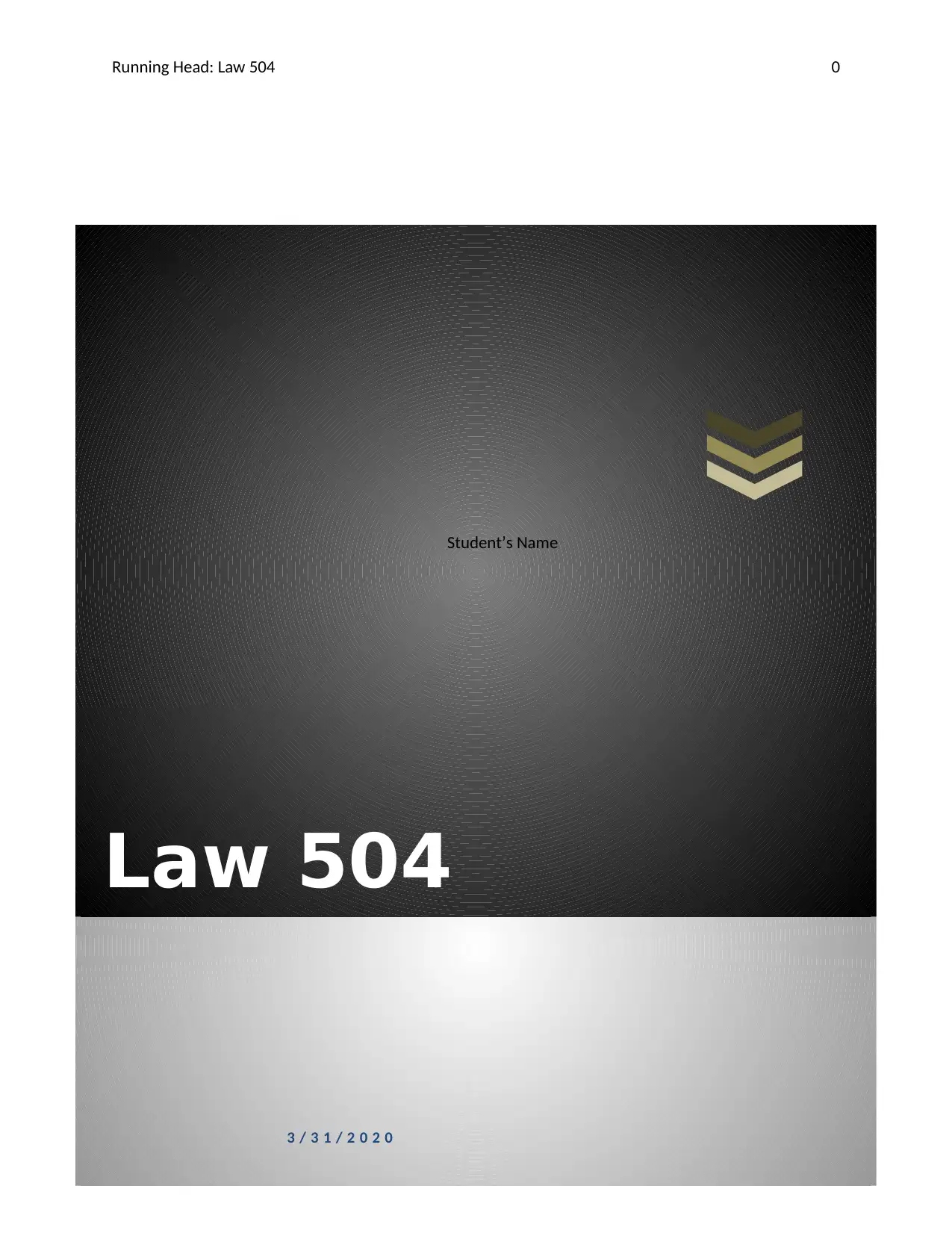
Law 504
Running Head: Law 504 0
3 / 3 1 / 2 0 2 0
Student’s Name
Running Head: Law 504 0
3 / 3 1 / 2 0 2 0
Student’s Name
Paraphrase This Document
Need a fresh take? Get an instant paraphrase of this document with our AI Paraphraser
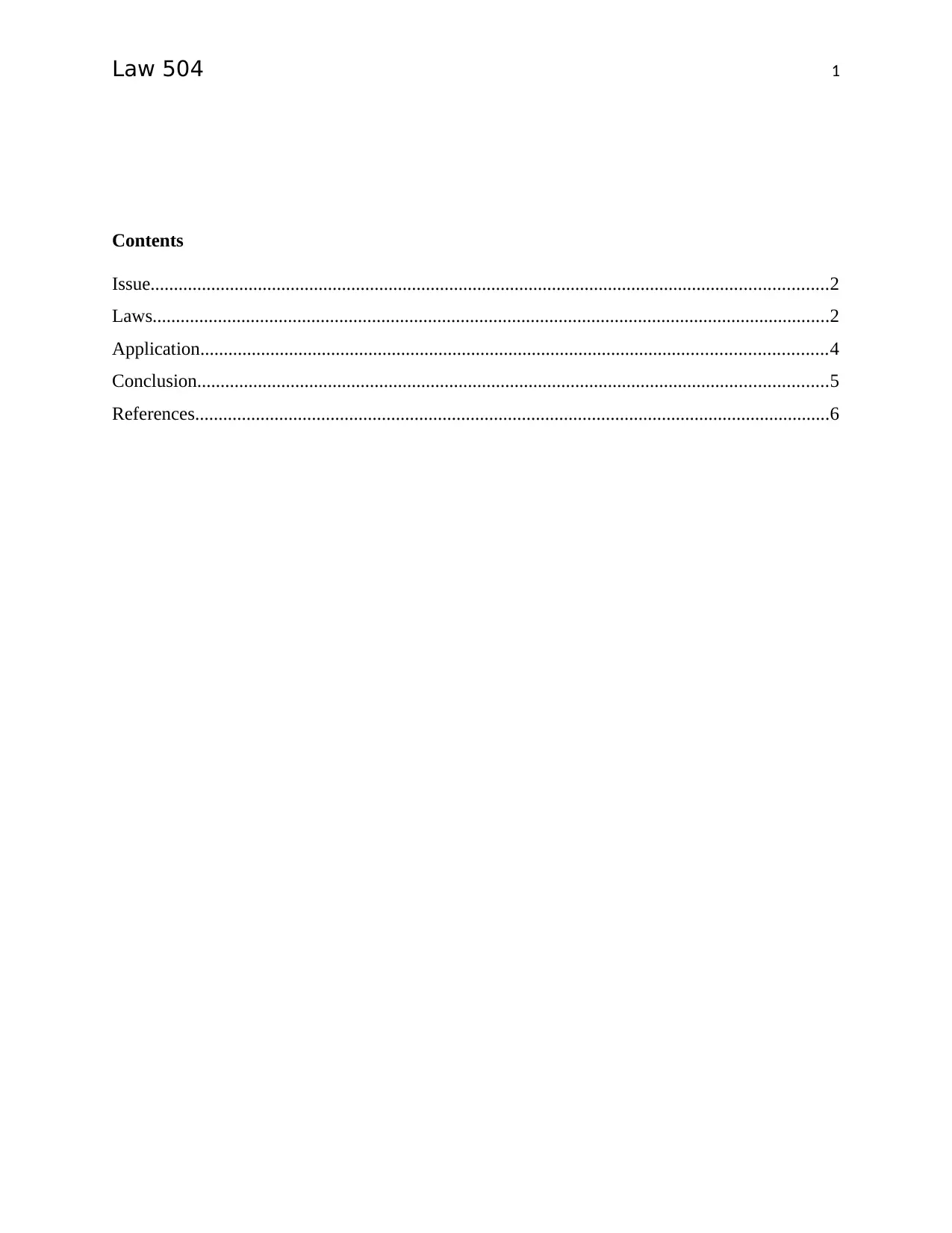
Law 504 1
Contents
Issue.................................................................................................................................................2
Laws.................................................................................................................................................2
Application......................................................................................................................................4
Conclusion.......................................................................................................................................5
References........................................................................................................................................6
Contents
Issue.................................................................................................................................................2
Laws.................................................................................................................................................2
Application......................................................................................................................................4
Conclusion.......................................................................................................................................5
References........................................................................................................................................6
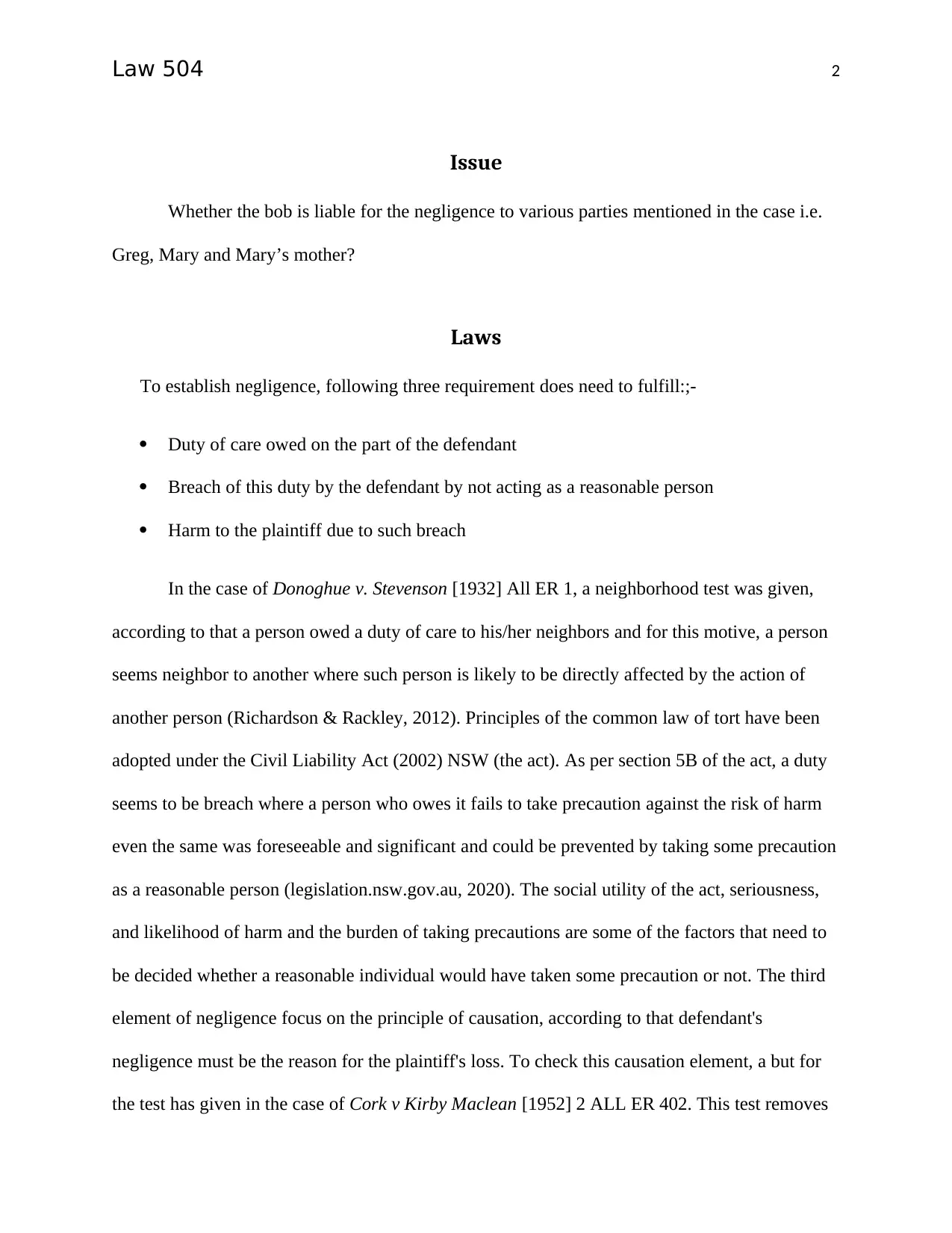
Law 504 2
Issue
Whether the bob is liable for the negligence to various parties mentioned in the case i.e.
Greg, Mary and Mary’s mother?
Laws
To establish negligence, following three requirement does need to fulfill:;-
Duty of care owed on the part of the defendant
Breach of this duty by the defendant by not acting as a reasonable person
Harm to the plaintiff due to such breach
In the case of Donoghue v. Stevenson [1932] All ER 1, a neighborhood test was given,
according to that a person owed a duty of care to his/her neighbors and for this motive, a person
seems neighbor to another where such person is likely to be directly affected by the action of
another person (Richardson & Rackley, 2012). Principles of the common law of tort have been
adopted under the Civil Liability Act (2002) NSW (the act). As per section 5B of the act, a duty
seems to be breach where a person who owes it fails to take precaution against the risk of harm
even the same was foreseeable and significant and could be prevented by taking some precaution
as a reasonable person (legislation.nsw.gov.au, 2020). The social utility of the act, seriousness,
and likelihood of harm and the burden of taking precautions are some of the factors that need to
be decided whether a reasonable individual would have taken some precaution or not. The third
element of negligence focus on the principle of causation, according to that defendant's
negligence must be the reason for the plaintiff's loss. To check this causation element, a but for
the test has given in the case of Cork v Kirby Maclean [1952] 2 ALL ER 402. This test removes
Issue
Whether the bob is liable for the negligence to various parties mentioned in the case i.e.
Greg, Mary and Mary’s mother?
Laws
To establish negligence, following three requirement does need to fulfill:;-
Duty of care owed on the part of the defendant
Breach of this duty by the defendant by not acting as a reasonable person
Harm to the plaintiff due to such breach
In the case of Donoghue v. Stevenson [1932] All ER 1, a neighborhood test was given,
according to that a person owed a duty of care to his/her neighbors and for this motive, a person
seems neighbor to another where such person is likely to be directly affected by the action of
another person (Richardson & Rackley, 2012). Principles of the common law of tort have been
adopted under the Civil Liability Act (2002) NSW (the act). As per section 5B of the act, a duty
seems to be breach where a person who owes it fails to take precaution against the risk of harm
even the same was foreseeable and significant and could be prevented by taking some precaution
as a reasonable person (legislation.nsw.gov.au, 2020). The social utility of the act, seriousness,
and likelihood of harm and the burden of taking precautions are some of the factors that need to
be decided whether a reasonable individual would have taken some precaution or not. The third
element of negligence focus on the principle of causation, according to that defendant's
negligence must be the reason for the plaintiff's loss. To check this causation element, a but for
the test has given in the case of Cork v Kirby Maclean [1952] 2 ALL ER 402. This test removes
⊘ This is a preview!⊘
Do you want full access?
Subscribe today to unlock all pages.

Trusted by 1+ million students worldwide
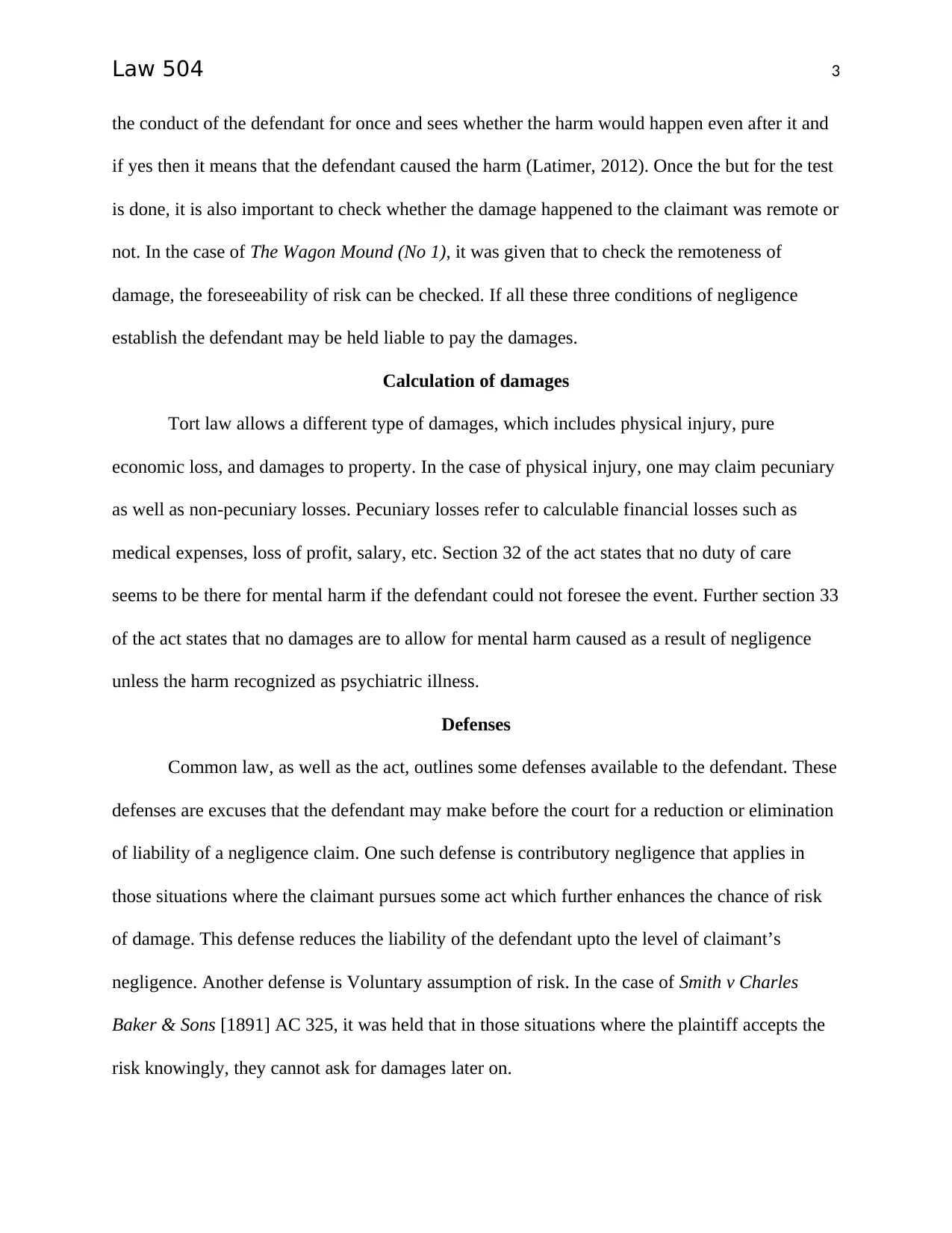
Law 504 3
the conduct of the defendant for once and sees whether the harm would happen even after it and
if yes then it means that the defendant caused the harm (Latimer, 2012). Once the but for the test
is done, it is also important to check whether the damage happened to the claimant was remote or
not. In the case of The Wagon Mound (No 1), it was given that to check the remoteness of
damage, the foreseeability of risk can be checked. If all these three conditions of negligence
establish the defendant may be held liable to pay the damages.
Calculation of damages
Tort law allows a different type of damages, which includes physical injury, pure
economic loss, and damages to property. In the case of physical injury, one may claim pecuniary
as well as non-pecuniary losses. Pecuniary losses refer to calculable financial losses such as
medical expenses, loss of profit, salary, etc. Section 32 of the act states that no duty of care
seems to be there for mental harm if the defendant could not foresee the event. Further section 33
of the act states that no damages are to allow for mental harm caused as a result of negligence
unless the harm recognized as psychiatric illness.
Defenses
Common law, as well as the act, outlines some defenses available to the defendant. These
defenses are excuses that the defendant may make before the court for a reduction or elimination
of liability of a negligence claim. One such defense is contributory negligence that applies in
those situations where the claimant pursues some act which further enhances the chance of risk
of damage. This defense reduces the liability of the defendant upto the level of claimant’s
negligence. Another defense is Voluntary assumption of risk. In the case of Smith v Charles
Baker & Sons [1891] AC 325, it was held that in those situations where the plaintiff accepts the
risk knowingly, they cannot ask for damages later on.
the conduct of the defendant for once and sees whether the harm would happen even after it and
if yes then it means that the defendant caused the harm (Latimer, 2012). Once the but for the test
is done, it is also important to check whether the damage happened to the claimant was remote or
not. In the case of The Wagon Mound (No 1), it was given that to check the remoteness of
damage, the foreseeability of risk can be checked. If all these three conditions of negligence
establish the defendant may be held liable to pay the damages.
Calculation of damages
Tort law allows a different type of damages, which includes physical injury, pure
economic loss, and damages to property. In the case of physical injury, one may claim pecuniary
as well as non-pecuniary losses. Pecuniary losses refer to calculable financial losses such as
medical expenses, loss of profit, salary, etc. Section 32 of the act states that no duty of care
seems to be there for mental harm if the defendant could not foresee the event. Further section 33
of the act states that no damages are to allow for mental harm caused as a result of negligence
unless the harm recognized as psychiatric illness.
Defenses
Common law, as well as the act, outlines some defenses available to the defendant. These
defenses are excuses that the defendant may make before the court for a reduction or elimination
of liability of a negligence claim. One such defense is contributory negligence that applies in
those situations where the claimant pursues some act which further enhances the chance of risk
of damage. This defense reduces the liability of the defendant upto the level of claimant’s
negligence. Another defense is Voluntary assumption of risk. In the case of Smith v Charles
Baker & Sons [1891] AC 325, it was held that in those situations where the plaintiff accepts the
risk knowingly, they cannot ask for damages later on.
Paraphrase This Document
Need a fresh take? Get an instant paraphrase of this document with our AI Paraphraser
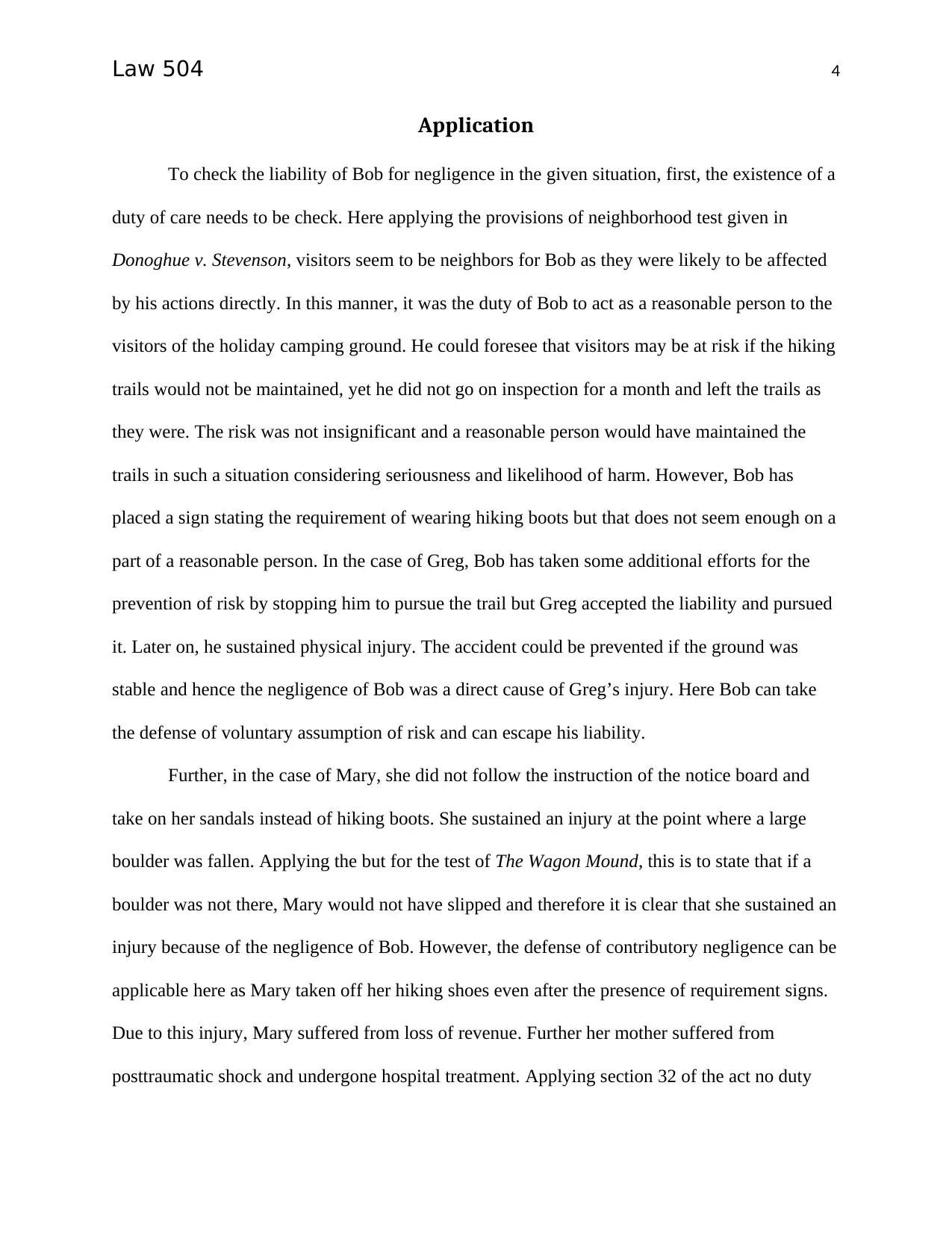
Law 504 4
Application
To check the liability of Bob for negligence in the given situation, first, the existence of a
duty of care needs to be check. Here applying the provisions of neighborhood test given in
Donoghue v. Stevenson, visitors seem to be neighbors for Bob as they were likely to be affected
by his actions directly. In this manner, it was the duty of Bob to act as a reasonable person to the
visitors of the holiday camping ground. He could foresee that visitors may be at risk if the hiking
trails would not be maintained, yet he did not go on inspection for a month and left the trails as
they were. The risk was not insignificant and a reasonable person would have maintained the
trails in such a situation considering seriousness and likelihood of harm. However, Bob has
placed a sign stating the requirement of wearing hiking boots but that does not seem enough on a
part of a reasonable person. In the case of Greg, Bob has taken some additional efforts for the
prevention of risk by stopping him to pursue the trail but Greg accepted the liability and pursued
it. Later on, he sustained physical injury. The accident could be prevented if the ground was
stable and hence the negligence of Bob was a direct cause of Greg’s injury. Here Bob can take
the defense of voluntary assumption of risk and can escape his liability.
Further, in the case of Mary, she did not follow the instruction of the notice board and
take on her sandals instead of hiking boots. She sustained an injury at the point where a large
boulder was fallen. Applying the but for the test of The Wagon Mound, this is to state that if a
boulder was not there, Mary would not have slipped and therefore it is clear that she sustained an
injury because of the negligence of Bob. However, the defense of contributory negligence can be
applicable here as Mary taken off her hiking shoes even after the presence of requirement signs.
Due to this injury, Mary suffered from loss of revenue. Further her mother suffered from
posttraumatic shock and undergone hospital treatment. Applying section 32 of the act no duty
Application
To check the liability of Bob for negligence in the given situation, first, the existence of a
duty of care needs to be check. Here applying the provisions of neighborhood test given in
Donoghue v. Stevenson, visitors seem to be neighbors for Bob as they were likely to be affected
by his actions directly. In this manner, it was the duty of Bob to act as a reasonable person to the
visitors of the holiday camping ground. He could foresee that visitors may be at risk if the hiking
trails would not be maintained, yet he did not go on inspection for a month and left the trails as
they were. The risk was not insignificant and a reasonable person would have maintained the
trails in such a situation considering seriousness and likelihood of harm. However, Bob has
placed a sign stating the requirement of wearing hiking boots but that does not seem enough on a
part of a reasonable person. In the case of Greg, Bob has taken some additional efforts for the
prevention of risk by stopping him to pursue the trail but Greg accepted the liability and pursued
it. Later on, he sustained physical injury. The accident could be prevented if the ground was
stable and hence the negligence of Bob was a direct cause of Greg’s injury. Here Bob can take
the defense of voluntary assumption of risk and can escape his liability.
Further, in the case of Mary, she did not follow the instruction of the notice board and
take on her sandals instead of hiking boots. She sustained an injury at the point where a large
boulder was fallen. Applying the but for the test of The Wagon Mound, this is to state that if a
boulder was not there, Mary would not have slipped and therefore it is clear that she sustained an
injury because of the negligence of Bob. However, the defense of contributory negligence can be
applicable here as Mary taken off her hiking shoes even after the presence of requirement signs.
Due to this injury, Mary suffered from loss of revenue. Further her mother suffered from
posttraumatic shock and undergone hospital treatment. Applying section 32 of the act no duty
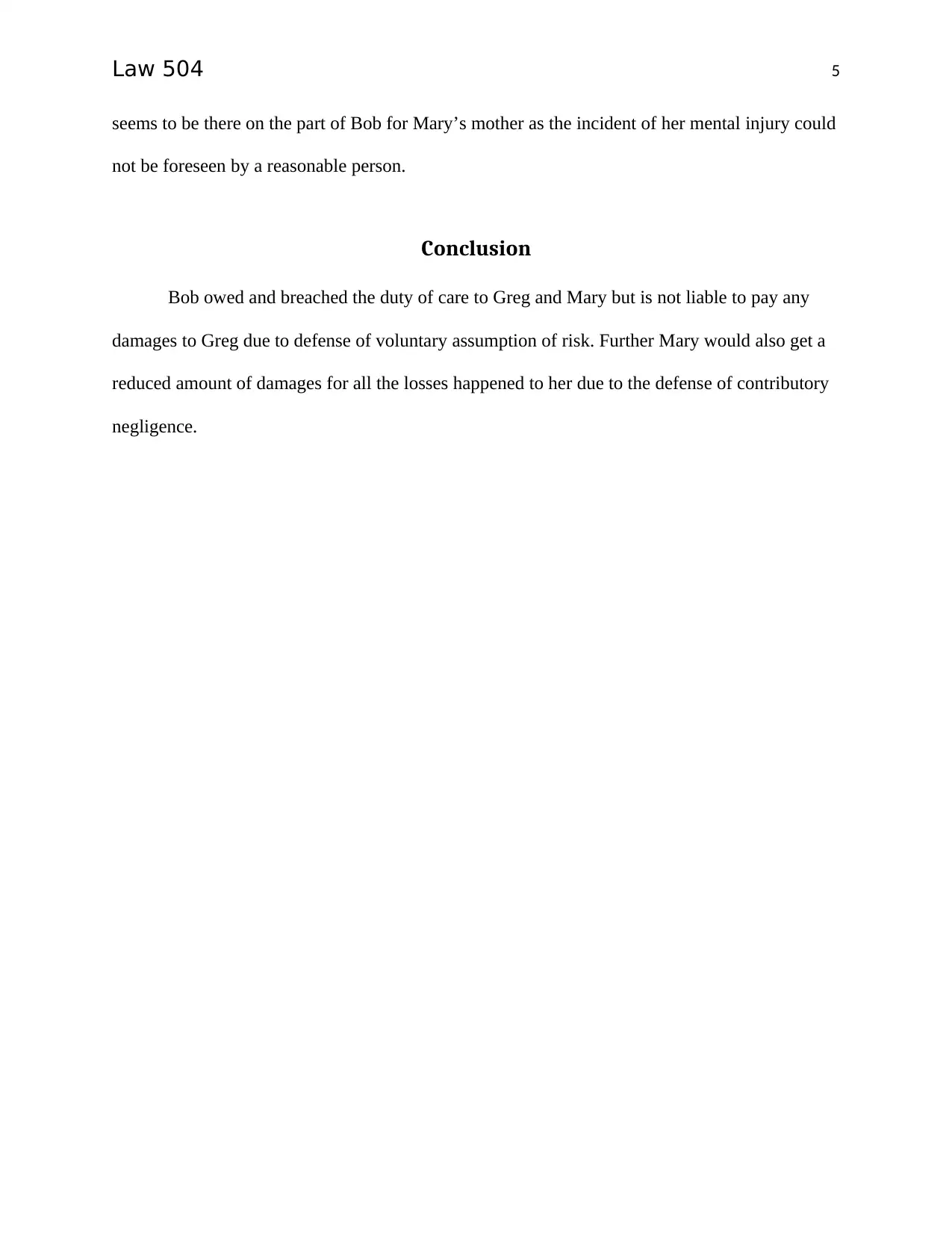
Law 504 5
seems to be there on the part of Bob for Mary’s mother as the incident of her mental injury could
not be foreseen by a reasonable person.
Conclusion
Bob owed and breached the duty of care to Greg and Mary but is not liable to pay any
damages to Greg due to defense of voluntary assumption of risk. Further Mary would also get a
reduced amount of damages for all the losses happened to her due to the defense of contributory
negligence.
seems to be there on the part of Bob for Mary’s mother as the incident of her mental injury could
not be foreseen by a reasonable person.
Conclusion
Bob owed and breached the duty of care to Greg and Mary but is not liable to pay any
damages to Greg due to defense of voluntary assumption of risk. Further Mary would also get a
reduced amount of damages for all the losses happened to her due to the defense of contributory
negligence.
⊘ This is a preview!⊘
Do you want full access?
Subscribe today to unlock all pages.

Trusted by 1+ million students worldwide
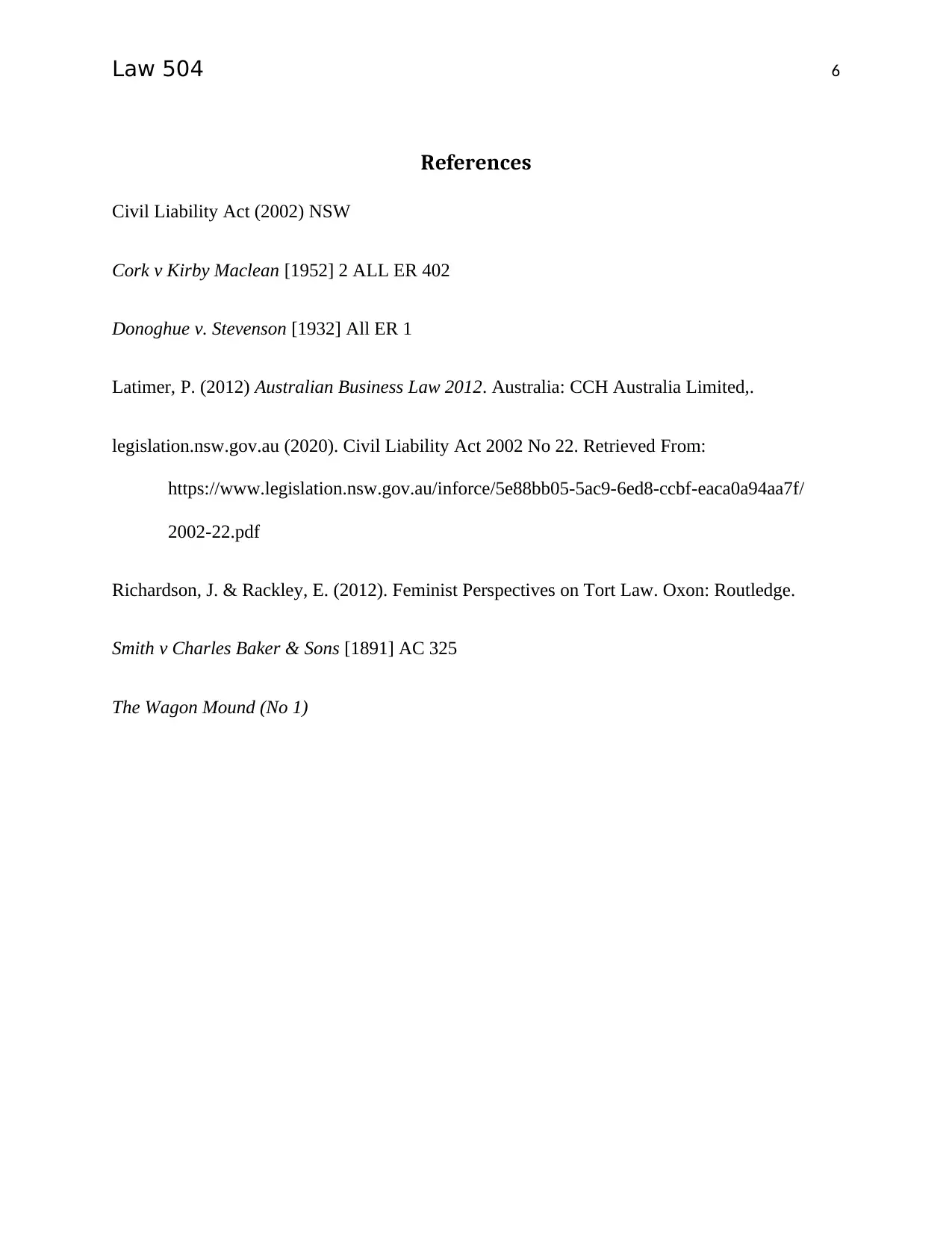
Law 504 6
References
Civil Liability Act (2002) NSW
Cork v Kirby Maclean [1952] 2 ALL ER 402
Donoghue v. Stevenson [1932] All ER 1
Latimer, P. (2012) Australian Business Law 2012. Australia: CCH Australia Limited,.
legislation.nsw.gov.au (2020). Civil Liability Act 2002 No 22. Retrieved From:
https://www.legislation.nsw.gov.au/inforce/5e88bb05-5ac9-6ed8-ccbf-eaca0a94aa7f/
2002-22.pdf
Richardson, J. & Rackley, E. (2012). Feminist Perspectives on Tort Law. Oxon: Routledge.
Smith v Charles Baker & Sons [1891] AC 325
The Wagon Mound (No 1)
References
Civil Liability Act (2002) NSW
Cork v Kirby Maclean [1952] 2 ALL ER 402
Donoghue v. Stevenson [1932] All ER 1
Latimer, P. (2012) Australian Business Law 2012. Australia: CCH Australia Limited,.
legislation.nsw.gov.au (2020). Civil Liability Act 2002 No 22. Retrieved From:
https://www.legislation.nsw.gov.au/inforce/5e88bb05-5ac9-6ed8-ccbf-eaca0a94aa7f/
2002-22.pdf
Richardson, J. & Rackley, E. (2012). Feminist Perspectives on Tort Law. Oxon: Routledge.
Smith v Charles Baker & Sons [1891] AC 325
The Wagon Mound (No 1)
1 out of 7
Related Documents
Your All-in-One AI-Powered Toolkit for Academic Success.
+13062052269
info@desklib.com
Available 24*7 on WhatsApp / Email
![[object Object]](/_next/static/media/star-bottom.7253800d.svg)
Unlock your academic potential
Copyright © 2020–2025 A2Z Services. All Rights Reserved. Developed and managed by ZUCOL.





